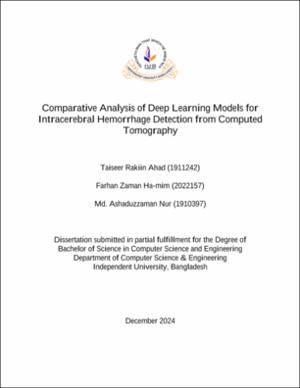| dc.description.abstract | Intracerebral hemorrhage (ICH) is a serious medical condition caused by bleeding within the brain tissue, which can lead to life-threatening complications if not diagnosed quickly. This study compares the performance of three advanced deep learning models, InceptionV3, DenseNet201, and EfficientNetB4, for detecting ICH from computed tomography (CT) scans. This work's novelty lies in preprocessing techniques such as windowing with Hounsfield Units and Skull segmentation to provide cleaner input data and Grad-CAM visualizations to ensure the model’s predictions are interpretable. Using comprehensive evaluations, including metrics like AUROC, precision, and F1 score, EfficientNetB4 achieved the best results with an accuracy of 0.85, precision of 0.87, and F1-score of 0.86, demonstrating its potential to assist medical professionals in making faster and more reliable diagnoses. | en_US |
